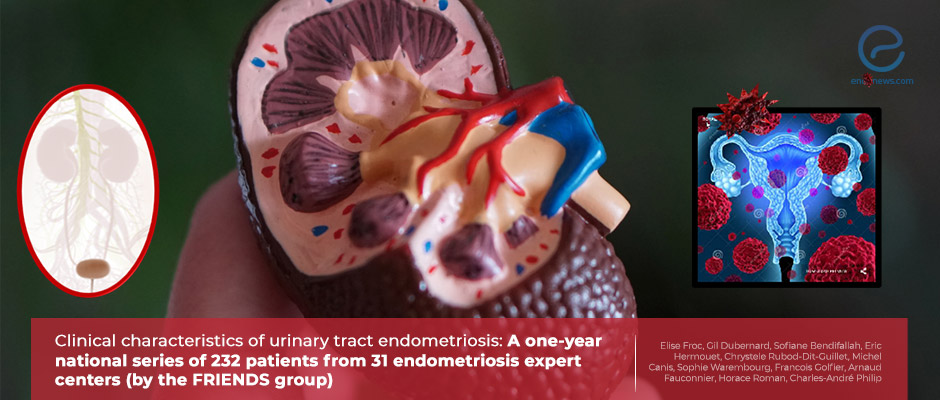Urinary Tract Endometriosis
Mar 23, 2022
Urinary tract endometriosis is rare, but important
Key Points
Highlights:
- Urinary tract endometriosis is a rare but important entity.
- Ureteral endometriosis is almost always associated with other deep endometriosis and is more often asymptomatic than bladder endometriosis.
Importance:
- Revealing the characteristics of patients with urinary tract endometriosis will increase the success of endometriosis treatment.
- The present study, which was the second-largest paper including patients with urinary tract endometriosis, demonstrating the clinical presentation, management options, and outcomes.
What's done here:
- The present study was planned in a prospective manner, and 31 highly experienced centers participated.
- Patients with at least one lesion in the ureter or bladder were enrolled, and patients under 18 years old and cases with solely ureterolysis without visible lesion were excluded.
- Patients’ demographic characteristics such as age, age at endometriosis diagnosis, parity-gravidity, history of surgery, urinary tract endometriosis properties, operation-related parameters, complications, and symptoms were recorded.
- Additionally, all surgeons filled a standardized 24-items questionnaire
Key Results:
- Totally, 232 patients with urinary tract endometriosis from 31 centers were enrolled, of which 74.2 % were treated in university hospitals and the remaining from private clinics.
- Total ureteral endometriosis and total bladder endometriosis were detected in 150 and 106 patients, respectively; 24 had both ureteral and bladder (mixed) endometriosis.
- Cystalgia, hematuria, and polyuria were significantly more common in patients with isolated bladder endometriosis, and almost half of the patients had at least one urinary symptom.
- Isolated ureteral endometriosis was mostly asymptomatic than other urinary tract endometriosis, but the presence of lower back pain and renal colic were significantly common.
- Computed tomography and renal scintigraphy have been used significantly more for isolated ureteral endometriosis, and cystoscopy was correlated with isolated bladder endometriosis.
- The presence of isolated ureteral endometriosis was related to pelvic endometriosis in comparison to other urological lesions.
- Hydronephrosis and ureteral dilatation were significantly more common in patients with isolated ureteral endometriosis; also DJ stent insertion was significantly more common.
Limitations:
- The present study focused on short-term results of UTE and the authors did not evaluate the long-term outcomes of urinary tract endometriosis.
- The authors did not mention surgeons’ skills which may affect the outcomes.
- The present study did not evaluate the cost.
Lay Summary
Endometriosis is mostly seen in patients of fertile age, and urinary tract endometriosis affects 1.2 to 6% of women with endometriosis.
French coloRectal Infiltrating ENDometriosis Study (FRIENDS) group investigated the characteristics of urinary tract endometriosis in 232 patients from 31 centers. Authors found that total ureteral endometriosis and total bladder endometriosis are the most common locations.
The results of this interesting study have recently been published in the European Journal of Obstetrics Gynecology and Reproductive Biology.
The authors stated that 47.8% of patients had at least one urinary symptom while cystalgia, hematuria, and polyuria were significantly more common in patients with isolated bladder endometriosis and lower back pain and renal colic were more common in patients with isolated ureteral endometriosis. Also, Computed tomography scans and renal scintigraphy have been used significantly more for isolated ureteral endometriosis, and cystoscopy has been chosen for isolated bladder endometriosis.
Moreover, hydronephrosis, ureteral dilatation, and DJ stent insertion were significantly common in patients with isolated ureteral endometriosis.
The present study is an important cornerstone to understand the diagnosis and surgical management of urinary tract endometriosis and to draw attention to a multidisciplinary approach for endometriosis management.
Research Source: https://pubmed.ncbi.nlm.nih.gov/34303076/
urinary tract endometriosis multidisciplinary approach cystalgia hematuria polyuria renal colic back pain

